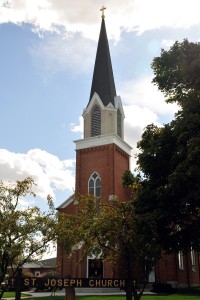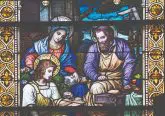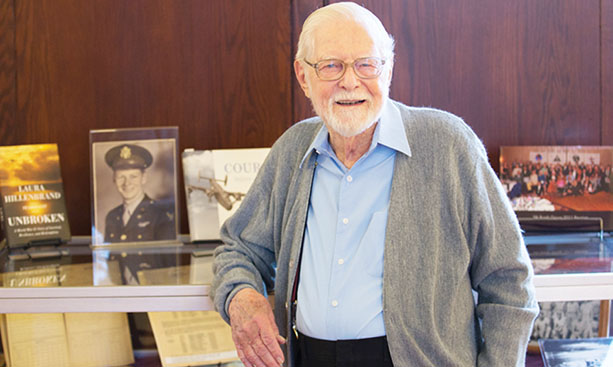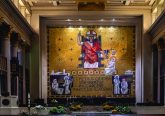St. Joseph Parish in Fort Recovery celebrates its 175th anniversary

By Sarah Anne Carter
For The Catholic Telegraph
Renovations made it possible for one 175-year-old church to show the community its building in a close to original state during a recent anniversary celebration.
A mural of St. Joseph and Jesus had been hidden behind a drop ceiling at St. Joseph Parish in Fort Recovery, about two hours north of Cincinnati, and was restored during a renovation in 2000.
“I have always considered it to be ‘the Wrigley Field of churches,’” said Father Thomas Dorn, pastor for the Catholic Community of Fort Recovery. “It is a rare gem, which was thankfully and mercifully spared ‘wreckovation’ in the misguided iconoclast fervor of the late 1960s and early 1970s.”
The ceiling mural was originally covered up with a drop ceiling in 1975 because the original ceiling needed significant repairs.
“There were people who found pictures of the church from different time periods,” said Gary Steinbrunner, a parishioner for 67 years. “We re-did the entire interior of the church and put it back to the way it was before Vatican II.”
St. Joseph had an anniversary celebration Mass Oct. 5, 2014 with Archbishop Dennis M. Schnurr presiding. Four former priests from the parish attended the Mass and a celebration dinner afterwards. The parish also opened the church for an open house and self-guided tours that afternoon.
“Father George Kuzara took a video of the interior of the church in 1999 before the renovations with an explanation of the windows and statues and that was streamed live on a big screen TV, “ Steinbrunner said. “There were identification cards on easels in front of the windows and statues, too.”
The parish was established in 1839 and the parishioners met in a log church. The building that is still currently in use for the parish was built in 1861. A tower and entrance were added in 1902 and the building was remodeled in 1918-1920 and again in 1999-2000. The original parishioners mostly came from the Archbundy of Baden, Germany. In 1851, the parish was able to have a dedicated priest from the Missionaries of the Precious Blood. They served at St. Joseph until 2006 when, due to fewer priestly vocations, they were unable to send a priest to Fort Recovery. At that time, the churches in Fort Recovery looked to share resources. The cluster participants have varied over the years, but St. Joseph was always in the forefront of pulling the churches together. Currently, the Catholic Community of Fort Recovery is made up of St. Joseph, St. Peter, St. Paul and Mary Help of Christians.
“Back in the day, St. Joseph was the mother church of all of the Ft. Recovery Cluster parishes,” Father Dorn said. “It is a farming community, located in a unique part of the archdiocese called ‘God’s country,’ in the heart of heartland USA, and its people reflect the best of traditional American and Catholic values. The church building itself, surrounded by beautiful farmland, is special too, as little has changed, with the original old-time confessional, baptismal font, elevated pulpit, and rope-pulled church bells.”
Father Dorn has served at St. Joseph for nine years.
“It has always held a special place in my heart,” he said. “I remember 12 years ago, as a young parochial vicar in nearby Coldwater, visiting this parish and thinking to myself, ‘I would love to be pastor here someday, but that would never happen because it is staffed by the Precious Blood fathers.’ Though, to the surprise of all, within three years, just as my term at Coldwater was ending, the Precious Blood fathers returned the parishes to the Archdiocese, and a diocesan pastor was needed. I jumped at the opportunity.”
“It started to raise fund to do maintenance on the church, priest house and grounds,” Steinbrunner said. “It generates enough funding to keep the buildings and grounds maintained.”
In 2009, St. Joseph tore down the priest house and used the foundation to build a hall for small gatherings. The hall was named after the Sanderall family, who donated a major portion of the funding for the building, according to Steinbrunner.
“It’s a great community that was born out of love for the Catholic faith,” said Julia Fullenkamp-Kremer, a lifelong parishioner. “I believe it’s special to people for different reasons. For me, it’s where I started. It’s where my ancestors are from. It is truly where my family began. For many others, it is the traditional Catholic beauty of the church. From the stained glass windows to old pipe organ, the church has been restored to its original decor. It is truly magnificent. We are fortunate to have such a beautiful place to worship.”
Six priests and 21 women who have joined religious orders have called St. Joseph home.
“We have been blessed with many members being called to the holy orders,” Fullenkamp-Kremer said. “I personally had two aunts become Sisters of the Precious Blood, an uncle become a Precious Blood Priest, as well as an uncle becoming a Brother. They were all very important to me and were active in my family’s life. I have been blessed to be part of such a great family and community.”
This story originally appeared in the February 2015 print edition of The Catholic Telegraph.













